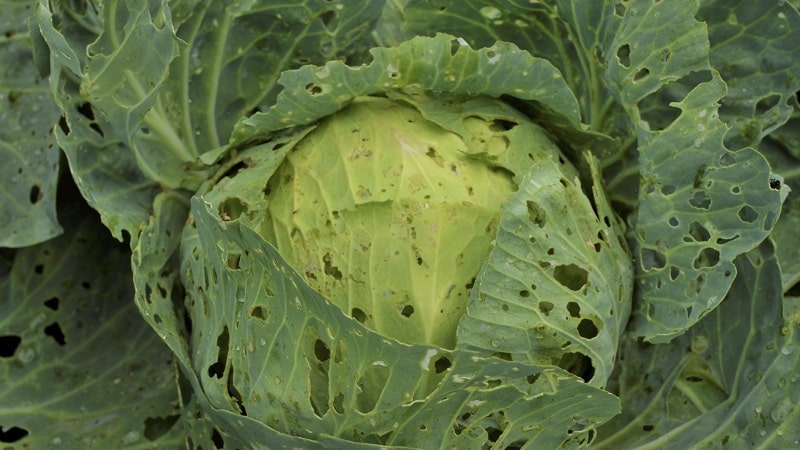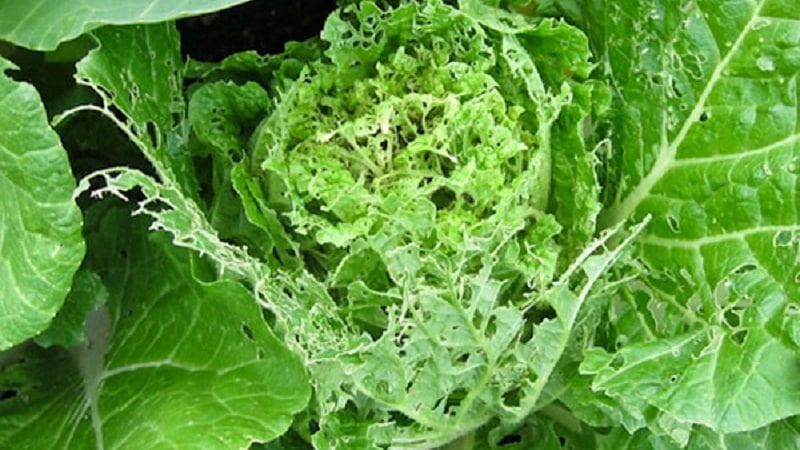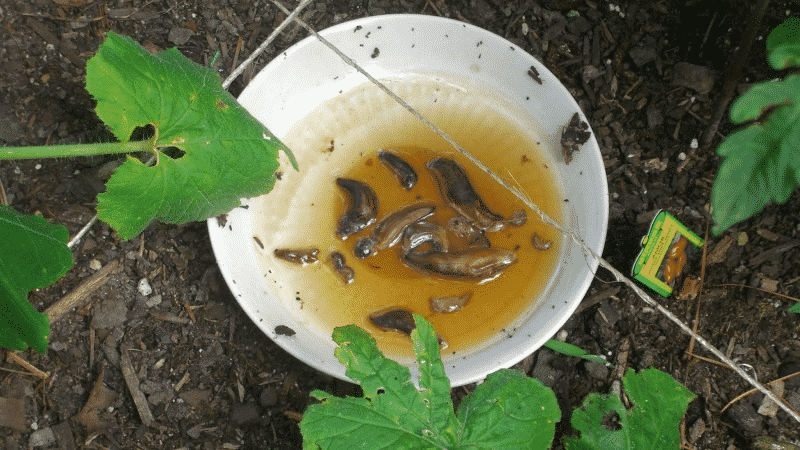What to do with holes in cabbage leaves
Holes in cabbage leaves indicate that pests have appeared in the garden bed. Insects tend to multiply quickly and are capable of completely destroying plantings in a short period of time. The article will tell you what to do if cabbage leaves have holes, what is the reason for this phenomenon and what folk remedies to use.
Why cabbage is full of holes - the main reasons
Holes in cabbage leaves may be caused by hail, but in good weather conditions this is a clear sign of pest damage to the crop.
First, several small holes appear, then they grow, there are more of them, and as a result the leaves look like a sieve.

Pests that attack leaves:
- Slugs and snails. Their usual environment is shade and humidity. They appear in beds with thickened plantings and stagnant water. Large areas of leaves are immediately eaten away. Nibbled edges, large holes and silvery traces of dried mucus will be noticeable.
- Cruciferous flea beetles - small black insects about 3 mm. They multiply massively in dry and hot weather, especially where there are a lot of weeds. They feed on young seedlings. Many pinholes are left on the leaves. Peak activity in May.
- Cruciferous bugs - colorful beetles up to 1 cm long. They pierce a leaf with their proboscis and feed on the juice. There will be many small holes with a yellow border on the leaf plate. They attack cabbage from May to June in dry weather.
- Cabbage moth caterpillars and cabbage white larvae. Favorable environment - heat and drought.They eat away the edges and bottom of the leaf. With mass distribution, the leaf is completely skeletonized (only the veins remain).
Cabbage gets its nutrition from the soil and through photosynthesis. Leaf damage slows down crop development and can cause fungal diseases.. It is advisable to inspect the plants more often. Insects are not always noticeable, but if holes appear on the leaves, you should immediately begin pest control.
Attention! Insects not only eat leaves, but also carry diseases.
What to do if cabbage leaves have holes
By the type of damaged leaf, the state of the bed and taking into account weather conditions, you can approximately determine the type of pest. Rain, high humidity and wet ground - it is worth looking for slugs; in the heat, in dry beds - caterpillars and small insects. Check the top layer of soil and both surfaces of the leaves.
If there is little damage, cabbage is treated with homemade remedies that you prepare yourself. Large pests are collected by hand.
For moderate lesions use biological drugs. These are new generation insecticides that are safe for humans and do not accumulate in plants. They act more slowly than chemical agents. The latter are used in critical situations, during a massive pest invasion. The instructions always indicate the permissible interval between processing and harvesting.
Attention! Insects become accustomed to the effects of chemicals. Every year it is necessary to alternate products with different active ingredients.
Insecticides approved for use on farms:
- biological - “Fitoverm”, “Lepidotsid”, “Biostop”, “Bitoxibacillin”;
- chemical - “Decis Profi”, “Pochin”, “Aktara”, “Karate”, “Ivermek”, “Fox”.
Cabbage apply in the morning (when there is still dew on the leaves) or in the evening (after 18.00). Soap is added to make the aqueous solution stick to the leaves. Chemicals are diluted without sediment, and herbal infusions are filtered.
Algorithm of actions if Chinese cabbage holes appeared:
- Inspect the plants and determine the type of pest.
- Depending on the degree of damage, choose a suitable means of control. In doubtful situations, drugs are used for a group of insects.
- Create an unfavorable environment for the pest: clear the area of weeds, loosen the soil or mulch the beds, water and spray the plants in dry weather.
- Treat cabbage with pest control. Spray all plants, even those with undamaged leaves. If it rains after 4-5 hours, treat again.
- Repeat 2-3 times with an interval of 5-8 days.
- Combine measures to combat and repel insects.

How to treat - folk remedies
Folk remedies are effective in the early stages of crop development, as preventive treatments, for small crop areas and at the first signs of pests. The main purpose is to repel insects and make cabbage leaves inedible to them.
Against slugs and snails:
- Mustard and ammonia. Dilute 2 tbsp in 1 liter of water. l. ammonia and 15 g of dry mustard. The product works in contact with the pest, so cabbage is sprayed late in the evening.
- Soda solution. Grind 20 g of laundry soap on a grater and dilute it in 10 liters of water. Add 3 tbsp. l. soda ash. Stir until dissolved. Spray the cabbage in the morning so that the product is completely dry by evening.
Against cruciferous flea fleas and bedbugs:
- Birch tar.It is difficult to dissolve in water, so it is first mixed with liquid soap. 1 tsp. tar and 1 tsp. soap is mixed and dissolved in 1 liter of warm water. The leaves are sprayed in the morning.
- Dandelion infusion. The flowers, along with the leaves and roots, are washed and ground in a meat grinder. 500 g of mass are diluted in 10 liters of water. Add 1 tsp. liquid soap and mix. Leaves are treated in the morning or evening.
- Soap solution. Coarsely rub 300 g of laundry soap and dissolve it in 10 liters of warm water. You can take liquid soap in a volume of 400 ml. Leaves are treated in the morning.
Against cabbage cutworm and white moth caterpillars:
- Vinegar. Dilute 1 tbsp in 10 liters of water. l. vinegar essence (70%) or 1 tbsp. vinegar (9%). Cabbage is sprayed in the evening.
- Infusion of ash. To 10 liters of water add 2 tbsp. ash and 1 tbsp. l. tar shampoo. Stir and leave for 24 hours. Before treating plants, shake the solution well.
Note! Any products containing vinegar, ammonia, tar, soda and soap, as well as herbal infusions with a pungent odor, are effective for simultaneous control of different types of pests.
What else can you do
It is rational to combine plant processing with manual collection of insects (if there are few of them) and placing traps.

For slugs:
- Half of the watermelon is peeled from the pulp. 3-4 holes are cut in the peel 1-3 cm from the edge. In the evening it is placed on the site upside down. By morning there will be several dozen slugs underneath, which are easy to collect. The watermelon peel is used for 2-3 nights and then replaced with a new one.
- In a plastic bottle or container, cut out 2-3 rectangular windows 3-4 cm above the bottom. The lower part is not cut off, but bent like a slope. Beer is poured into a container and placed on the site. The slugs will fall into the bottle and die.
Traps are not installed in cabbage beds, but next to the plants, which have hard leaves and slugs do not eat them.
Sticky traps are made for cruciferous flea beetles.. Resin, grease or mouse glue is applied to dense substrates and laid out between the bushes. The second option is to attach the substrate to a stick and swing it, hitting the cabbage bushes. Fleas jump out and stick.
Cruciferous bugs are distracted from the beds with decoys. White paper is soaked in cabbage juice and attached to the fence. Insects walk around the beds and strive for paper with a strong smell of cruciferous plants, from where they are shaken into a jar of kerosene. Store-bought bedbug traps are placed between the rows.
White color for white butterflies is a signal that the laying site is already occupied by a competitor. White disposable cups or bows from thick white bags are attached to branches or sticks and placed between the plants. The stick should be a few centimeters higher than the cabbage bush.
Interesting things on the site:
How and when to plant cabbage for seedlings and in open ground
Prevention methods
Insects overwinter in the upper layers of soil and plant debris. In early spring they begin to feed on weeds and then move to seedlings.
The goal of preventive work is to create the most unfavorable conditions for the life and reproduction of crop pests.
A set of preventive measures:
- Maintaining crop rotation. Cabbage is planted after beans, grains, root vegetables and cucumbers - no more than 2-3 years in a row in one place.
- Competent agricultural technology. Do not thicken the plantings, maintain optimal humidity for the crop.
- In autumn, loosen the top layer of soil and clear the area of plant debris.
- In the spring, during planting, the soil is treated with wood ash, tobacco dust, a mixture of soda and pepper, and mulched with pine needles.
- Companion plants are planted, the aroma of which repels pests: marigolds, fennel, calendula, dill.
- A week after planting in open ground, the seedlings are sprayed with a soap solution. Use herbal infusions, ash solution, water with the addition of vinegar, ammonia or essential oils (lemon, orange, lavender, fir). Spraying is repeated once every 2 weeks, even if there are no signs of pest damage.
- The beds and the ground around are cleared of weeds. Root watering is alternated with sprinkling.
Conclusion
Cabbage leaves with a hole in them are a sign of pest infestation. Folk remedies will help in the fight against a small number of insects: homemade traps, soil cultivation and spraying with solutions with a pungent odor.
Cabbage accumulates harmful substances, so chemical insecticides are used only in critical situations. It is more rational to prevent pest invasions than to fight them later.